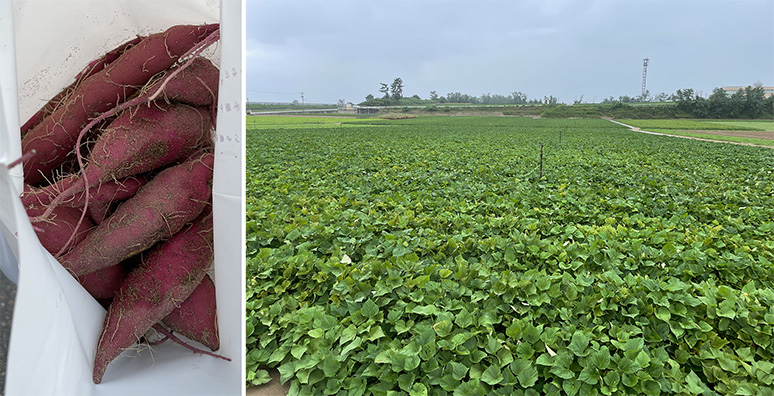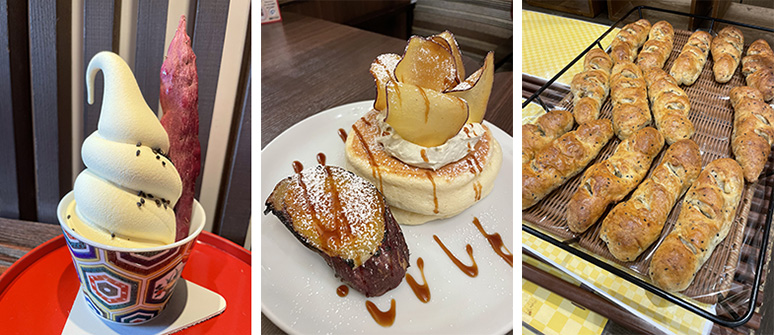
Gorojima Kintoki sweet potatoes produced in Kanazawa City, Ishikawa Prefecture (left), and the fields where they are grown (right)
Photos: Massimiliano Sgai
Italian Massimiliano Sgai has attracted attention in Japan and overseas for his articles and books on Japanese cuisine. We interviewed him about the appeal of sweet potato, a delicious ingredient, and Japanese cuisine using it, which he would like to recommend to visitors from overseas.
When I first came to Japan in 2002, I was amazed by the unique Japanese food culture. The one product that surprised and impressed me the most was actually satsuma-imo (sweet potato).* I have never encountered such a rich and profound vegetable, and I wish that more people overseas could enjoy sweet potato dishes, which are still little known even as Japanese cuisine has spread around the world. I believe that by experiencing its appeal through all five senses, they will be able to enjoy Japanese food culture and come to love Japan even more. This time I will share with you the reason I fell in love with sweet potatoes and the best gourmet dishes that can be prepared with them.
First of all, let’s forget that sweet potatoes are vegetables. There are countless ways to cook sweet potatoes, but whether they are used in Western or Japanese confectionery, home cooking or fine Japanese cuisine, a dish that takes advantage of their natural sweetness will leave you feeling satisfied and a moment of peace. For example, sweet potato tempura** has an irresistible crisp and crunchy texture, and its sweetness is doubled when it is eaten hot. Sprinkled with salt or dipped in tempura sauce called tentsuyu,*** it tastes and feels unforgettable. Another simple yet profoundly Japanese dish that you should try is satsuma-imo takikomi gohan**** (sweet potato rice). It is a wonder how white rice and sweet potatoes, simply cooked together, can create such a rich and nutritious flavor experience. The sweetness of the potato takes on a different form no matter what it is paired with.

Sweet potato tempura. It has a crisp and crunchy texture and is served with salt or tentsuyu (bottom photo).
Photos: ISHIZAWA Yoji

Rice cooked with sweet potatoes
Photo: Massimiliano Sgai
If you have a chance to visit the Hokuriku region, ***** I recommend that you try a variety of sweet potato called Gorojima Kintoki, ****** which is part of the Kaga-Yasai brand of indigenous vegetables. ******* Compared to other sweet potato varieties, it is characterized by a tender texture and deep sweetness and flavor. When cooked, its refined sweet taste is even more pronounced, making it twice as enjoyable in any dish. Follow the local tradition of enjoying metta-jiru, a specialty found nowhere else in Japan, and you will take home memories to cherish. Metta-jiru is a type of rich and hearty ton-jiru******** prepared with various root vegetables, such as sweet potatoes, daikon radish, and carrots. The term “Japanese cuisine” is often used, but this kind of unique regional cuisine “kyodo cuisine” ********* that is rooted in each and every region of the country is also very deep and diverse.
For those with a sweet tooth, I recommend not only traditional Japanese confectionery made with sweet potatoes, but also bread, cakes, doughnuts, ice cream, and other treats. For a taste of Japanese food culture while traveling, try a steaming hot yaki-imo. ********** As a gift, I recommend the sweet potato yokan. *********** Its texture is uniquely Japanese sweets, and the sweetness of the potato is sure to fill you with a sense of happiness. Both sweet potato cakes and candied sweet potatoes(in Japanese, it is called “Daigakuimo”) can be enjoyed for their distinct textures, and they look so different from each other that you may not even realize that they are made with the same main ingredient: sweet potatoes. There are also sweet potato-filled breads and pastries, and sweet potato chips. You might think that some of these foods originated overseas, but even here it is possible to find exquisite Japanese gourmet foods.

Roasted sweet potatoes (yaki-imo) (left) and sweet potato yokan, a confectionery that offers a unique texture (right)
Photos: ISHIZAWA Yoji

Also recommended are Western-style desserts and pastries made with sweet potatoes (from left to right: sweet potato ice cream, sweet potato pancakes, sweet potato bread).
Photos: Massimiliano Sgai
The Japanese sweet potato is a magical vegetable that can be prepared in an infinite number of ways and served in a variety of dishes. The combination of such a magical vegetable with the creativity of the Japanese results in delicious dishes that deserve to be called “the best.” If you ever visit Japan, be sure to try various sweet potato dishes.

Massimiliano Sgai
Originally from Italy, Massimiliano Sgai now lives in Kanazawa City, Ishikawa Prefecture. He graduated from the Department of Japanese Language at the Graduate School of Letters of the University of Turin, and moved to Japan in 2007. After gaining experience as a Japanese-Italian interpreter, he went on to work as a food and lifestyle writer. He is the author of the book, Italia-jin Massi ga Buttonda, Nihon no Kami-gurume (“Japan’s Divine Culinary Treats That Astonished the Italian, Massi”) (KADOKAWA), as well as a number of magazine articles and serialized columns. He writes about the fascinating differences between Italian and Japanese culture, the appeal of Japanese food, and delicious food arrangements from an Italian’s point of view. His long-selling series The Complete Guide to Saizeriya (note) has over 1.5 million page views. Currently, he is involved in a variety of activities ranging from writing serialized columns and essays to planning and copywriting.![]()
* A vine with edible tuberous roots. Native to tropical America, it was introduced to Japan in around the 17th century. After that, in the 18th century, its cultivation spread rapidly throughout the nation, and from the 20th century onwards, full-scale breeding improvements were made, and it has continued to grow to this day.
** Tempura is a traditional Japanese dish of seafood or vegetables coated in a flour-based batter and deep-fried in oil.
*** Tentsuyu is a dipping sauce that complements tempura. It is prepared by simmering three basic ingredients: soy sauce, mirin (sweet cooking rice wine), and dashi (soup stock).
**** Takikomi gohan is a dish made by cooking rice with ingredients such as seafood, meat, and wild vegetables. Generally, sweet potato rice is made by mixing rice with sweet potatoes diced into 1 to 2 cm pieces with the skin on, and cooking them together. It is seasoned with condiments such as soy sauce and salt.
***** A region on the coast of the Sea of Japan in central Honshu, comprising the four prefectures of Ishikawa, Fukui, Toyama, and Niigata.
****** Gorojima Kintoki sweet potato is one of the Kaga-Yasai indigenous vegetables. It is cultivated in Kanazawa City, Ishikawa Prefecture, and is characterized by its intense sweetness. It is said that cultivation began during the Genroku period (1688 to 1704).
******* The Kaga-Yasai brand of indigenous vegetables includes produce cultivated mainly in Kanazawa City, Ishikawa Prefecture, which has been certified as brand vegetables by the Kanazawa City Agricultural Produce Branding Association.
******** Tonjiru, a traditional Japanese home-style dish, is a soup made with pork and vegetables, and flavored with miso, etc. Miso is a condiment made by steaming soybeans and other ingredients and fermenting them with salt, etc.
********* A type of cuisine that is unique to a particular region and uses local products as ingredients.
********** Roasted sweet potatoes. Stone-roasted sweet potatoes, which are prepared by heating stones from underneath and cooking the potatoes on the top of the stones, are particularly well known.
*********** A type of traditional Japanese confectionery prepared by steaming and mashing sweet potatoes and adding sugar.
By Massimiliano Sgai
Photo: Massimiliano Sgai; ISHIZAWA Yoji
PREVIOUS
[Discovering Japan Through the Eyes of Japanese Influencers] From Maiko to Influencer: The Charm of Kyoto’s Gokagai, Five Traditional Entertainment Districts

NEXT
[The Beauty of Japanese Swords] “Long Sword (Tachi) ” Bearing Yasuie’s Inscription

Feedback and Comments
Thank you for your feedback
Your valuable feedback and commnents will be referenced for our future operations.
Close

![[Treasures of Japanese Culture] Italian Food Writer Recommends the Best Gourmet Food in Japan: Enchanted by the Magical Vegetable Sweet Potato | NOVEMBER 2024 [Treasures of Japanese Culture] Italian Food Writer Recommends the Best Gourmet Food in Japan: Enchanted by the Magical Vegetable Sweet Potato | NOVEMBER 2024](https://www.diningandcooking.com/wp-content/uploads/2025/05/hj_2024_11_11_00.webp.webp)